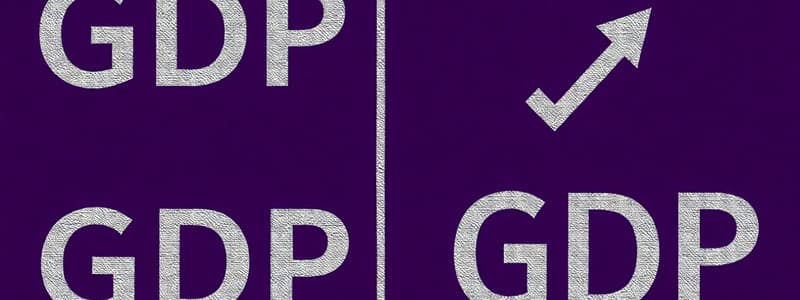Podcast
Questions and Answers
Based on Table 20-7, what was the approximate real GDP in 2011, expressed in 2002 prices?
Based on Table 20-7, what was the approximate real GDP in 2011, expressed in 2002 prices?
- $798 000
- $869 200
- $800 000
- $773 585 (correct)
- $900 000
Referring to Table 20-7, what is the approximate implicit GDP deflator for 2012?
Referring to Table 20-7, what is the approximate implicit GDP deflator for 2012?
- 94
- 110
- 108
- 109
- 107 (correct)
Using the data in Table 20-7, calculate the approximate growth rate of nominal output from 2010 to 2011.
Using the data in Table 20-7, calculate the approximate growth rate of nominal output from 2010 to 2011.
- 3.36%
- 4.27%
- 4.09%
- 2.76% (correct)
- 5.00%
Based on Table 20-7, determine the approximate growth rate of real output from 2011 to 2012.
Based on Table 20-7, determine the approximate growth rate of real output from 2011 to 2012.
Referring to Table 20-8, what was the nominal Gross Domestic Product in 2012?
Referring to Table 20-8, what was the nominal Gross Domestic Product in 2012?
According to Table 20-8, what was the real GDP in 2012, expressed in 2011 prices?
According to Table 20-8, what was the real GDP in 2012, expressed in 2011 prices?
Based on Table 20-8, what is the implicit GDP deflator in 2012, using 2011 as the base year?
Based on Table 20-8, what is the implicit GDP deflator in 2012, using 2011 as the base year?
Referring to Table 20-8, what is the implicit GDP deflator in 2012 (using 2012 as the base year)?
Referring to Table 20-8, what is the implicit GDP deflator in 2012 (using 2012 as the base year)?
Based on Figure 20-1, which year served as the base year for constructing real GDP?
Based on Figure 20-1, which year served as the base year for constructing real GDP?
Referring to Figure 20-1, by approximately what percentage did nominal GDP increase between 1995 and 2000?
Referring to Figure 20-1, by approximately what percentage did nominal GDP increase between 1995 and 2000?
Referring to Figure 20-1, real GDP increased by approximately what percentage between 1995 and 2000?
Referring to Figure 20-1, real GDP increased by approximately what percentage between 1995 and 2000?
If nominal GDP in a certain year is $3800 and the GDP deflator for that year is 152, then what is the real GDP for that year?
If nominal GDP in a certain year is $3800 and the GDP deflator for that year is 152, then what is the real GDP for that year?
Which of the following statements accurately describe a country's computed GDP deflator?
Which of the following statements accurately describe a country's computed GDP deflator?
Consider Canada's GDP deflator and Consumer Price Index (CPI). Suppose the prices of various goods and services increased. Which price increase is likely to have a larger effect on the GDP deflator than on the CPI?
Consider Canada's GDP deflator and Consumer Price Index (CPI). Suppose the prices of various goods and services increased. Which price increase is likely to have a larger effect on the GDP deflator than on the CPI?
Consider Canada's GDP deflator and Consumer Price Index (CPI). Now suppose the prices of the following goods and services increased. Which is likely to have a larger effect on the CPI than the GDP deflator?
Consider Canada's GDP deflator and Consumer Price Index (CPI). Now suppose the prices of the following goods and services increased. Which is likely to have a larger effect on the CPI than the GDP deflator?
What is one major reason that GDP might be an inaccurate measure of the true level of economic activity?
What is one major reason that GDP might be an inaccurate measure of the true level of economic activity?
What is one major reason that GDP is an inaccurate measure of the 'quality of life'?
What is one major reason that GDP is an inaccurate measure of the 'quality of life'?
Why does real GDP tend to overstate the economic well-being of a country's residents?
Why does real GDP tend to overstate the economic well-being of a country's residents?
How might measures of GDP understate the economic well-being of people in developing countries?
How might measures of GDP understate the economic well-being of people in developing countries?
Which statement accurately describes the underground economy and its relationship to GDP?
Which statement accurately describes the underground economy and its relationship to GDP?
Which of the following is included in current calculations of GDP?
Which of the following is included in current calculations of GDP?
Why does Statistics Canada exclude the value of goods and services exchanged 'under the counter' from GDP?
Why does Statistics Canada exclude the value of goods and services exchanged 'under the counter' from GDP?
Why are illegal activities, unreported activities, and non-market activities excluded from GDP?
Why are illegal activities, unreported activities, and non-market activities excluded from GDP?
Which of the following is excluded from GDP?
Which of the following is excluded from GDP?
Using GDP as a measure of the economic well-being of a country can be criticized for ignoring non-market and other activities. However, it remains useful because:
Using GDP as a measure of the economic well-being of a country can be criticized for ignoring non-market and other activities. However, it remains useful because:
Flashcards
Nominal GDP
Nominal GDP
GDP using current prices. It reflects both changes in price and quantity.
Real GDP
Real GDP
GDP adjusted for inflation, reflecting only changes in quantity.
GDP Deflator
GDP Deflator
A measure of the price level calculated as the ratio of nominal GDP to real GDP.
Growth Rate
Growth Rate
Signup and view all the flashcards
Non-Market Activities
Non-Market Activities
Signup and view all the flashcards
Underground Economy
Underground Economy
Signup and view all the flashcards
Consumer Price Index (CPI)
Consumer Price Index (CPI)
Signup and view all the flashcards
GDP in Developing Countries
GDP in Developing Countries
Signup and view all the flashcards
GDP Exclusions
GDP Exclusions
Signup and view all the flashcards
Usefulness of GDP
Usefulness of GDP
Signup and view all the flashcards
Limitations of GDP
Limitations of GDP
Signup and view all the flashcards
Implicit GDP deflator
Implicit GDP deflator
Signup and view all the flashcards
Real GDP and Well-being
Real GDP and Well-being
Signup and view all the flashcards
Study Notes
- Real GDP in 2011, expressed in 2002 prices, was $773,585 (Table 20-7).
- The implicit GDP deflator for 2012 is approximately 107 (Table 20-7).
- The growth rate of nominal output from 2010 to 2011 is 2.76% (Table 20-7).
- The growth rate of real output from 2011 to 2012 is 3.41% (Table 20-7).
- The nominal Gross Domestic Product in 2012 was $1760 (Table 20-8).
- The real GDP in 2012, expressed in 2011 prices, was $1260 (Table 20-8).
- The implicit GDP deflator in 2012 (using 2011 as the base year) is 139.7 (Table 20-8).
- The implicit GDP deflator in 2012 (using 2012 as the base year) is 100 (Table 20-8).
- Figure 20-1 uses 2003 as the base year for constructing real GDP.
- Nominal GDP increased by approximately 45% between 1995 and 2000 (Figure 20-1).
- Real GDP increased by approximately 17% between 1995 and 2000 (Figure 20-1).
- If nominal GDP is $3800 and the GDP deflator is 152, then the real GDP is $2500.
- A country's computed GDP deflator excludes changes in the price of imported goods, is less relevant than the measured CPI for the typical consumer, and is set to be equal to 100 in its base year.
- An increase in the prices of forest products is likely to have a larger effect on the GDP deflator than the CPI.
- An increase in the prices of consumer electronics is likely to have a larger effect on the CPI than the GDP deflator.
- GDP is an inaccurate measure of the true level of economic activity because it does not include non-market activities.
- GDP is an inaccurate measure of the "quality of life" because it does not include the value of leisure.
- Real GDP tends to overstate the economic well-being of a country's residents by ignoring the economic "bads" associated with production, such as pollution.
- Measures of GDP may understate the economic well-being of people in developing countries if those countries tend to have a large share of nonmarket activities.
- Transactions in the underground economy are legal but are not reported for tax purposes, therefore not included in GDP.
- Computers produced and exported are included in current calculations of GDP.
- Statistics Canada excludes the value of goods and services exchanged "under the counter" from GDP because satisfactory methods for their measurement have not been developed.
- Illegal activities, unreported activities, and non-market activities are excluded from GDP because they are difficult to measure.
- The purchase price of illegal drugs sold by a drug dealer is excluded from GDP.
- Using GDP as a measure of economic well-being can be criticized for ignoring non-market and other activities, but it remains useful because the change in GDP from one year to the next is a good indication of the change in economic activity.
Studying That Suits You
Use AI to generate personalized quizzes and flashcards to suit your learning preferences.




